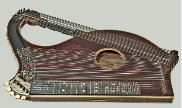The article touches upon the basic problems of the classical translation versions of culturally relevant vocabulary of Chinese language, mostly used in literary translations. The author of the article attempts to analyze the reasons for the culturally relative mistranslations of lexical units that are tightly incorporated into the Russian translation tradition; to support the general idea of the article, the author tries to give grounds for historical, cultural and other reasons of the mistranslations mentioned above; provides illustrative examples of the mistranslated words and the Chinese objects they were mistaken with.
Keywords: Chinese, Russian, translation, mistranslation, culture.
В статье рассматривается базовая проблематика классических вариантов перевода культурно-окрашенной лексики в названиях китайских произведений культуры и искусства, художественных текстов. Автор предпринимает попытку анализа причин культурно-относительной некорректности перевода лексических единиц, плотно вошедших в российскую переводческую традицию, а также обосновывает историко-культурные и иные причины, поддерживающие его точку зрения, приводятся наглядные примеры сравнения ошибочно применённых в переводе слов и объектов, действительно относящихся к переводимым реалиям китайской культуры.
Ключевые слова: китайский язык, культура, перевод.
The history of Chinese to Russian translations is now dating back at least to the 19’th Century and is proved to be connected with Russian Orthodox Church missionary Nikita Y. Bichurin (also known as Father Iakinf), who was the head of The 9’th Russian Christian mission to Beijing back in 1808–1821. He is also known to be the first Russian sinologist being rather well-known in Europe. He not only held the vast research on Emperor Qianlong and Jiaqin’s China, translating historical, geographical, political works and so on, but also compelled his translations and wrote many of his own research papers. The main works of Father Iakinf are: A collection of information about the peoples who lived in Central Asia in ancient times (1851); Notes on Mongolia (1828); A statistical description of the Chinese Empire (1842); Agriculture in China (1844); China in a civil and moral state (1848).
As we can see, the time the first attempts of Chinese to Russian translations were undertaken is rather early, so that we can say at that time some kind of over domestication could be quite normal, as it was the mainstream of translation work that time and Russian translation thought as well as Russian language and its vocabulary is yet to be greatly transformed in the future.
But since 20 th Century was the booming time for Chinese poetry translations both by professional sinologists such as V. Alekseev, A. Ivanov, V. Vasiliyev and famous Russian (Soviet) poets such as A. Fet or A. Akhmatova, who used Russian metaphrase translation as the basis for their rhymed version of the text; we’d like to draw some attention to the top five words culturally wronged in many and many classical translations. And in authors opinion, that became an issue, especially now, when following the tradition became essential and there more and more people taking this kind of cultural and factual mistakes not for granted, but for the truth itself. Let’s take a brief look on the table below:
Table 1
Author’s TOP-5 mistranslated need-to-be-explained words from Chinese to Russian translations
|
№ |
The incorrect Russian translation (correct translation) |
English literal translation or Russian variant (accurate to Chinese original translation) |
Chinese original |
|
1. |
Яшма (нефрит) |
Jasper (jade) |
玉 |
|
2. |
Фрейлина (гуйфэй, драгоценная наложница) |
lady-in-waiting (guifei, Noble Cincubine) |
贵妃 |
|
3. |
Фея (небожительница\бессмертная) |
Fairy (fairy, immortal) |
仙女、仙子 |
|
4. |
Шахматы (вэйци\сянци) |
Chess (chess, go) |
棋 |
|
5. |
Цитра, лютня (цинь\гуцинь) |
Citer, lute (citer, qin) |
琴 |
The first example is not only first by the order in the table, but also in terms of usage number. We assume that every average Russian speaking person could have encountered Chinese Culture & History related content, translated as well as the original one, which is displaying the beautiful treasures of Chinese masters or explains mythology or religions and how they are melted in modern society. Every single piece of this kind obviously can refer to the rare objects made of jade , ex. Queen Xiwangmu’s Jade Pond or the Jade Emperor. And the thing is that historically Russian sinologists decided to use the word “яшма (jasper)” to replace the word “нефрит (jade)” in terms of non-rising unwilling thoughts of kidney disease named “pyelo nephritis ”, which colloquially would be called “нефрит ( nephritis )” which is the same to the Russian word used for jade [3]. So that digging through books on mythology and culture, the reader can easily face both Xiwangmu’s “Яшмовый пруд (Jasper Pond)” and “Нефритовый пруд (Jade Pond)” or Jasper Pond, but Jade Emperor instead, which could unintentionally lead the reader into the one delusion: there are Jasper and Jade both equally relevant in Chinese culture.
The issue is that jasper and jade are both well-known minerals, that can be quarried in many places around the world, the two have extremely different features and chemical formula.
To illustrate the difference between the two words used to translate Chinese character 玉(Jade) into Russian language, let’s take a brief look at the Fig. 1 and 2:
|
|
|
|
Fig. 1. Яшма (jasper) SiO2 |
Fig. 2. Нефрит (jade) Ca₂(Mg,Fe)₅Si₈O₂₂(OH)₂ |
We can notice that the situation didn’t change greatly over the years and even modern translators working on such great pieces of Chinese literature such as Mo Yan’s “Red Gaoliang” or “Life and death are wearing me out” are still using “яшма (jasper)” instead of “нефрит (jade)”, when the Chinese original is 宝玉 (precious jade). This can once more illustrate the seriousness of the issue.
The second example from the table is also laying down deep in history, but this time is more connected with the particular piece of Chinese traditional art (《贵妃醉酒》translated as “Охмелевшая фрейлина (Drunk Lady-in-Waiting)”). We encountered this translation in the Chinese to Russian translation handbook written by V. Shitchko [5; p.89], and after checking up on this piece of music, noticed that it is rather popular version title’s translation into Russian. The thing is that the word used in Chinese original is 贵妃 (Noble Concubine), is referring not to the “lady-in-waiting”, or to the imperial made, if you please, but to the highest ranked imperial consort, the second one after the Empress herself — Noble Concubine Yang, also known as Yang Yuhuan or Yang-guifei. And of course, the time this translation appeared the translator might have not known who the title is referring to exactly, but the word used in this version of translation has wronged the very basis of Ancient Chinese society.
Let us explain the point: the word “фрейлина (lady-in-waiting)” came to Russian from German language and means the highest ranked female servant of the Empress or the Royal Princess (Great Duchess in Russia), that time ladies-in-waiting were chosen from the noble families to serve in the palace by the side of Her Majesty or Her Highness. When Chinese 贵妃, as we already explained earlier, is referring to the highest rank of imperial consort, or using a better word, imperial wife. This much we already can see the greatest difference between the original and the translation. And the only thing that could be somehow in common between the two is that both Russian “фрейлина” and Chinese “贵妃” were supposed to be chosen from the nobles. That’s all.
We’d like the third, the fourth and the fifth example to be combined in one rather big topic by the most likely source of mistranslation. As it can be seen from the Table 1, examples from 3 to 5 have one common feature: there is the exact same English translation with and without brackets. This is the exact reason why we decided to combine the topic in one and speak more about the pre-conditions and consequences of such situation. First, back in the 18 th Century Russian thought was more or less Europeanized, so that all the new things people encountered with were perceived via European or Slavic point of view, people were not likely to give new names to the new objects from different cultures, but more likely to domesticate these new objects to those they think are quite the same to new ones. In other words, if people encountered a chess-like game, they would call it chess, not weiqi, or more popular English name for that game — go . Encountered citer-like music instrument — go with citer then and so on.
Now this approach was slowly replaced with its antipode — language barbarity when people are picking up many rather unnecessary words from other languages and start using it out of fashion on a daily basis. But in our opinion, the truth is somewhere in between.
Let’s start with the word 仙女 which can be rightfully translated into English as Fairy , but the same time can’t be translated as “Фея (Fairy)” into Russian and that’s why: in English-speaking countries fairy is a kind of supernatural beings or spirits, among them pixies are those who have smaller size and wings on their back. Fairies not necessarily have wings. But as from the Russian-speaking perspective, “фея (fairy)” — is a supernatural creature obligatory with the wings. But does any of Chinese traditional 仙子 have a pair of wings? The answer is “no”. That’s why we strongly believe that, in contrary with traditionally used translation, the word “Фея (Fairy)” can’t be used as a translation for Chinese 仙子, except for the situations we have visual or any other evidence letting us to tolerate a translation variant “Фея (Fairy)” in a particular context. In other case, the best way to translate 仙子 into Russian, on our opinion would be to use words “небожительница, бессмертная (celestial, immortal)” reflecting the Chinese mythology idea of Celestial kingdom, where these 仙子 are supposed to live.
To continue, quite the same thing happened to the Chinese 棋 (both 围棋and 象棋), as nowadays there are lots of unauthorized translations of Chinese content using “Шахматы (Chess)” to name the two Chinese games mentioned above. Thanks to V. Shitchko, we could trace the reason why 棋 could be translated as “облавные шашки (checkers)” [5, p. 80], it was a matter of pure resemblance and maybe even not quite far from the native meaning of the word 围棋. But current chess-situati on is rather different as we speak about unauthorized translations, which are probably using English as the source language instead of Chinese. So that this traditionally excepted as English translation for Chinese 棋 is now greatly affecting a large amount of Russian language information that could be found all over the Internet. It is much preferable to use “вэйци (weiqi)” and “сянци(xiangqi)” when the translating content is touching upon accordingly 围棋and 象棋.
At last, we’d like to mention the two rather comic situations can be massively encountered when reading about Chinese musical instrument called 古琴 or simply 琴. As with the chess-situation , we have an outstanding problem with Chinese-English-Russian bridge translation and as a result a large number of times when qin became a “цитра (citer)” in Russian. Historically, there are evidence that when first encountered this music instrument, Russian people were to call it a “Chinese citer”, but “citer” without adding a “Chinese” would automatically refer to European music instrument, which can resemble with qin in quite a way.
But more interesting is how translator’s handbook by V.Shitchko translates Chinese idiom 对牛弹琴into Russian. Because in this situation 琴 is translated not as “citer”, like we’ve mentioned above, but as “лютня (lute)” [5; p.104], which is also a European music instrument, but does not even resemble with qin at all. In contrary, it resembles more of another Chinese music instrument 琵琶 greatly.
Let us illustrate the issue with the pictures 3–6, so that the difference between the four music instruments could be seen:
|
|
|
|
Fig. 3. Цитра (Citer) |
Fig. 4. Цинь, гуцинь (琴、古琴) |
In conclusion, we’d like to share one major piece of thought: maybe our judgments can seem a bit unrealistic or ill-founded, but what we really standing for is culturally right translations that can bring masses to the understanding of the long and vivid Chinese History and Culture. So that we feel sorry that there are a few known-to-be reliable Chinese to Russian translation books which are claimed to be the must-read for the future translators and interpreters, but the same time being written in the middle or in the end of 20 th Century, these books already can’t fully apply to all the modern translation issues and specialties, still holding on to traditionally misunderstood or misrelated words. It arises even more questions, as at this point it is already not quite a matter of following Russian translation tradition, or performing a fundamentally, theoretically right translation, but also a matter of holding up to making the severe factual mistakes repeatedly. Which is leading to the total misunderstanding of Chinese Culture by the masses, who eventually encountered these under questioned translations.
References:
1. Масленникова Е. М. Культурная трансформируемость и адаптируемость художественного текста при переводе [Электронный ресурс] Человек в информационном пространстве: сборник научных трудов. — URL: http://yspu.org/images/3/33/Maslennikova %D0 %95M.pdf
2. Мясников B. C. Попова И. Ф. Вклад о. Иакинфа в отечественную синологию: К 225-летию со дня рождения члена-корреспондента Н. Я. Бичурина. Вестник Российской Академии Наук. Том 72. № 12. 2002.
3. Смирнов И. С. Китайская поэтическая классика в русских переводах: школы, традиции, имена. — [Электронный ресурс] Материалы лекции — 2016. URL: https://polit.ru/article/2016/08/13/smirnov_lecture/
4. Чэнь П. Отец Иакинф (Бичурин) в современном Китае. — Вестник Чувашского университета. 2017. № 4
5. Щичко, В. Ф. Китайский язык. Теория и практика перевода. Учебное пособие — М.: ВКН, 2010.











